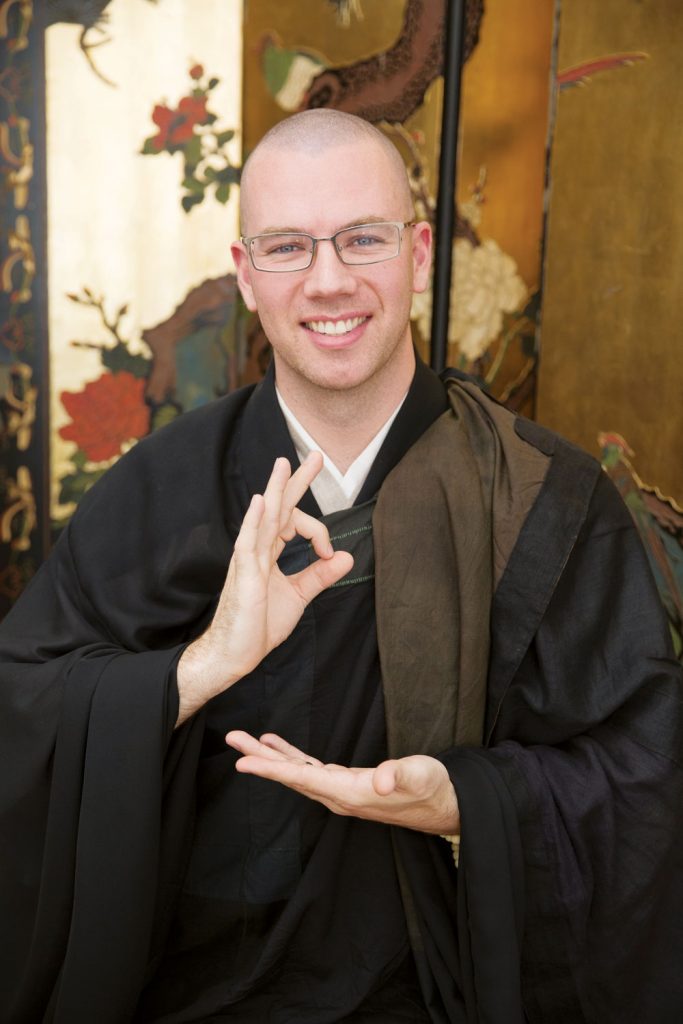Age: 32
Profession: Zen priest / art therapist / artist
Location: New York, NY
How has being deaf shaped your experience of receiving and transmitting the dharma? I have to say first that it was an obstacle. Zen is very intimate—the transmission of the dharma hinges on discipleship. We gain access to our teacher’s mind through one-on-one transmission and exposure. I have had to rely on other forms of communication, and that affects the psychological dynamics of the teacher-disciple relationship. And being the only deaf person in the zendo has often been a very “othering” feeling. About a year and a half ago, I started the No Barriers Zen Temple in Washington, D.C., with the intention to work more intelligently with communities of differently abled people. It’s not a deaf-only space, but many members of the D.C. Deaf community join us, and we organize our services to accommodate them. What I’m aiming for with the center is a paradigm shift: when people from the general D.C. community come, I have to tell them that I need to get them a sign language interpreter. And they say, “Oh, no, no, I can hear.” And I say, “Right, but you can’t sign, so we’re going to need to get you a sign language interpreter.” They don’t get it! It takes a while for them to make the shift of “Oh, I need an interpreter because I’m functioning in a different space.” I’m not immune to those kinds of assumptions as a deaf person, by the way. I have a blind student who was talking to me once about all the accommodations that sighted people need. I said, “I don’t need accommodations. I’m not blind.” And they said, “Oh? What’s with all these lightbulbs? Lightbulbs are a sighted person’s accommodations.”
What first led you to the dharma? My mother. She gave me a book on Buddhist meditation. I grew up in a chaotic environment, and I decided that this would be my way to escape, to get out. Of course, good contemplatives know that you don’t escape anything; you only get more in touch with whatever’s going on. But I didn’t know that at the time, so I twisted my legs up and tried really hard to learn all the stuff in the book. That led me to reading all the books on Buddhism at my local library. Then I met a monk by chance and became his formal disciple when I was 14 years old. I moved through a series of teachers and lineages until finally landing with the White Plum Asangha about ten years ago. The dharma has come full circle for me now. In a roundabout way my mother was my first meditation teacher, and now my main teacher, [Village Zendo abbot] Roshi Pat Enkyo O’Hara, is a noble female and lesbian, just like my mother. Finding the Village Zendo felt like coming home, because the abbot and vice-abbot are both gay, and they reminded me quite a lot of my moms. Paging Dr. Freud! [Laughs.] There’s always been a lineage of strong women practitioners and leaders in my life, supporting me and guiding me through my studies and practice—even with regard to my deafness. Throughout my childhood education, I had tutors who were also ASL interpreters, and they tended to be women as well.
Zen is a tradition that experiments with language. How does the use of ASL change a Zen expression of the dharma? That’s a really fun question. My teacher has encouraged me to interpret chants and teachings into ASL, which is a challenge because ASL is such a different language in the way that it functions and holds meaning. My first translation was the four bodhisattva vows, and I would sign it when the rest of the zendo was chanting. Certain members of our community were really supportive and wanted to learn it too, so a few of us would sign it together in the morning. And then it caught on like wildfire. Now on a Sunday you see the whole zendo signing the four bodhisattva vows while we chant. People at the zendo often tell me that the vows feel different to them when they sign. They’re becoming aware of the body consciousness of signing, the impact signing is having on them. The sign for “save” is a good example: [crosses closed fists over chest, uncrosses them slowly to open]. Signing this is such a liberating, opening feeling. Or here’s another example from the Verse of the Kesa: “Vast is the robe of liberation.” When you sign “vast,” your body must physically become vast. [Opens arms wide.] When you sign “robe,” you metaphorically don a robe. ASL functions as a technology, much like the early mudras do.
You teach meditation for beginners. What draws you to teaching new and inquiring practitioners? I enjoy the dialogue with students—they bring such fresh perspectives. It’s a cliché, but I learn from them as much as they learn from me, especially in regard to meditative perspective. At No Barriers Zen, I have two deaf-blind students. On only the second or third time one of them meditated, he said to me, “I can see myself meditating, but what do I do about the one who is watching the watcher?” [Laughs.] It was a very abstract, advanced concept—who is the one that sees? What is mind? I think with something like deafness or blindness— or specifically deaf-blindness, where you are so within yourself—it’s almost its own wisdom tradition. Listening and learning from differently abled students has been very powerful.
Thank you for subscribing to Tricycle! As a nonprofit, we depend on readers like you to keep Buddhist teachings and practices widely available.
